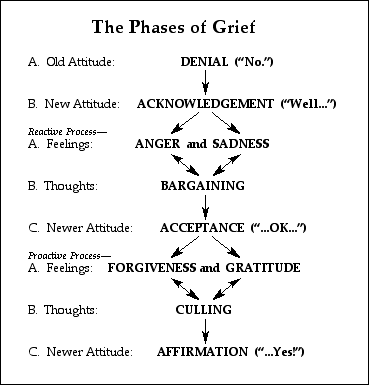In the Service of a Good Grief

A major theme that we must all eventually confront in this very human condition is grief.
At one time or another the deep mourning of a significant loss troubles every one of us. Sadly, in many cases, it is an experience that is never fully resolved. An accumulated scar tissue of bitterness often remains behind, long after the wounds have seemed to heal, and we become progressively less flexible, less trusting.
Even the acceptance of a loss does not help us if it is a begrudging acceptance. The map given with this article is intended to help explore and understand the stages of consciousness that grief can bring us through, moving beyond this begrudging acceptance to integrate the entire experience and make it a part of our maturing sense of self.
In her seminal work on the subject, Elizabeth Kubler-Ross outlined a sequence of four or five steps that she had identified in the normal experience of grief. Beginning with the acknowledgment of a loss that had until then been denied, the rhythmic alternation of sadness and anger begins to emerge, feelings that increasingly deepen until a bargain is struck with the experience, a negotiation so to speak that allows an acceptance of the situation.
In my work I have found these steps describe only the first half of grief, the reactive half, bringing us from a denial to an acceptance, from telling ourselves “no, it could not happen” to becoming able to say “okay, I can accept that it happened— but I still don't like it very much.”
The second half of the process is a more proactive part, and therefore the part that heals. Similar in form to the first half, it is based upon an alternation of the more positive feelings of forgiveness and gratitude. Together they put anger and sadness into a context that can contain them, and protect us from becoming overwhelmed by them. Then we are able to sort through the experience of an apparent loss to recognize the gains that have also taken place. This helps us to an eventual affirmation that “yes indeed, it all did happen, the gain and the loss; and I know that, as these experiences define me, I am ultimately made more complete by them.”
Forgiveness here is the proactive response to anger. It does not invalidate the vehement personal judgment that loss is morally wrong, but it goes on to recognize a greater judgment than our own that can comprehend such loss. Gratitude, likewise, is the proactive response to sadness which places it in the larger context of an appreciative regard, and a more inclusive, healing attitude toward the experiences of life.
When my mother had returned from her last travels about the world she gave me a set of wooden worry beads that she had been given by a Greek fisherman. We all understood she was dying, despite our struggles to grasp what that could mean. A year or so afterwards, while having ice cream with my family in a neighborhood ice cream parlor, I heard the little bell over the shop door ring as it opened and an older woman came in. Immediately, I knew my mother would never walk back into the room that way, and I found myself, finally, at the absolute depth of my sadness about her death.
My wife reached out to me and said, softly, “She’s not coming back, Jim.” As certain as I was that all I had gained by being her son would remain with me— including the simple wooden beads I still carried in my pocket— so too I was certain she herself now had no need to return. This moment brought me to a final forgiveness, a final gratitude, and a deeper appreciation of life.
This sorting, culling, assimilating process is the final phase of grief, when we get to know what we may bring along with us, and we get to let go of what we cannot keep. In the understanding that something done has not therefore failed, like some great symphony, what we have grieved now is something simply complete, and completely satisfying.
Return to Clinical Commentary
